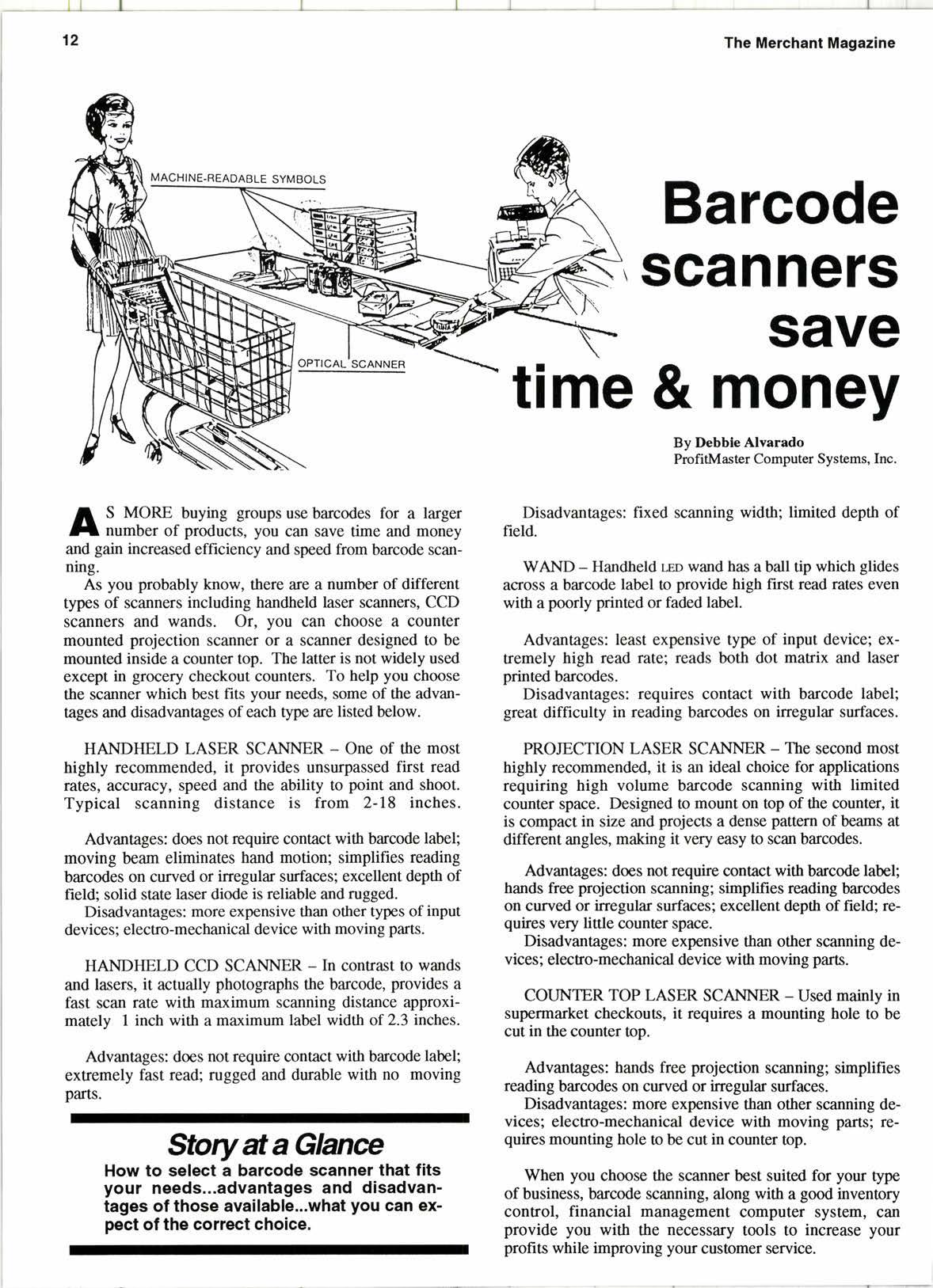
2 minute read
Barcode 'scanners save time & money
By Debble Alvarado ProfitMaster Compute,r Systems, Inc.
S MORE buying groups use barcodes for a larger number of products, you can save time and money and gain increased efficiency and speed from barcode scanning.
As you probably know, there are a number of different types of scanners including handheld laser scanners, CCD scanners and wands. Or, you can choose a counter mounted projection scanner or a scanner designed to be mounted inside a counter top. The latter is not widely used except in grocery checkout counters. To help you choose the scanner which best fits your needs, some of the advantages and disadvantages of each type arc listed below.
HANDIIELD LASER SCANNER - One of the most highly recommended, it provides unsurpassed first read rates, accuracy, speed and the ability to point and shoot. Typical scanning distance is from 2-18 inches.
Advantages: does not require contact with barcode label; moving beam eliminates hand motion; simplifies reading barcodes on curved or irregular surfaces; excellent depth of field; solid state laser diode is reliable and rugged.
Disadvantages: more expensive than other types of input devices; electro-mechanical device with moving parts.
HANDHELD CCD SCANNER - In contrast to wands and lasers, it actually photographs tle barcode, provides a fast scan rate with maximum scanning distance approximately 1 inch with a maximum label width of 2.3 inches.
Advantages: does not require contact with barcode label; extremely fast read; rugged and durable with no moving pafis.
S"tory at a Glane
How
Disadvantages: fixed scanning width; limited depth of field.
WAND - Handheld mo wand has a ball tip which glides across a barcode label to provide high first read rates even with a poorly printed or faded label.
Advantages: least expensive type of input device; extremely high read rate; reads both dot mafrix and laser printed barcodes.
Disadvantages: requires contact with barcode label; great difficulty in reading barcodes on irregular surfaces.
PROJECTION LASER SCANNER - The second most highly recommended, it is an ideal choice for applications requiring high volume barcode scanning with limited counter space. Designed to mount on top of the counter, it is compact in size and projects a dense pattern of beams at different angles, making it very easy to scan barcodes.
Advantages: does not require contact with barcode label; hands free projection scanning; simplifies reading barcodes on curved or irregular surfaces; excellent depth of field; requires very little counter space.
Disadvantages: more expensive than other scanning devices; electro-mechanical device with moving parts.
COUNTER TOP LASER SCANNER - Used mainly in supermarket checkouts, it requires a mounting hole to be cut in the counter top.
Advantages: hands free projection scanning; simplifies reading barcodes on curved or irregular surfaces.
Disadvantages: more expensive than other scanning devices; electro-mechanical device with moving parts; requires mounting hole to be cut in colmter top.
When you choose the scanner best suited for your type ofbusiness, barcode scanning, along with a good inventory control, financial management computer system, can provide you with the necessary tools to increase your profits while improving your customer service.
E) UILD a positive relationship bePween vour sales staff and customers by suggesting the proper type of fasteners for power-driven installations of plywood siding, floor sheathing and underlayment and then being able to solve and prevent potential problems.
Years ago, the American Plywood Association recommended only handdriven stainless steel nails and hotdipped or hot-tumbled galvanized nails for installing plywood siding. Most commonly available types had only a thin protective coating or plating, which resulted in a sinilarly low resistance to rusting and eventual staining of the siding when exposed to weather.
But in recent years, manufacturers of power-driven fasteners have improved the plating processes to increase their fasteners' resistance to rusting and staining. APA now recommends power-driven fasteners as an acceptable substitute for handdriven fasteners, provided they are of equivalent size and quality.
Suggested are: o Aluminum nails. o Galvanized stainless steel nails (chromate-coated for added corrosion prot€ction). o High quality aluminum-plated stainless steel staples (the quality of the plating is important).
Story at a Glance
Help your customers make the right connections when installing plywood with power nailers and staplers... tips tor making and keeping happy customers.










